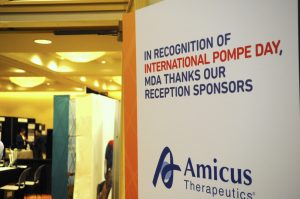Fascination With Pompe Led Miami Neurologist to Netherlands Years Ago

Pamphlets from Sanofi Genzyme promote International Pompe Day at the 2019 MDA Conference in Orlando. (Photo by Larry Luxner)
Few people have heard of Pompe disease, and even fewer know anything about Joannes Cassianus Pompe — the Dutch pathologist who in 1931 characterized the rare disorder that carries his name, and who just 14 years later was killed by the Nazis for aiding the Allies during World War II.
On April 15, biochemical geneticist R. Rodney Howell told an audience of more than 1,200 people how his fascination with the disease led him to the Netherlands some 30 years ago.
Howell, president of the Muscular Dystrophy Association, spoke at the 2019 MDA Clinical and Scientific Conference in Orlando, Florida.
“Today is International Pompe Day, and that has led me to some personal reminiscences,” said Howell, 87, chairman of the pediatrics department at the University of Miami’s Miller School of Medicine. “The enzyme defect in Pompe was discovered about 50 years ago. At the time, it was quite popular to make that diagnosis on children suspected with the disease. All the patients who were referred to Dr. Pompe were infants with very large hearts. I was very interested in this condition because we would see children in our clinic and diagnose them with Pompe disease using cultured skin cells, based on the enzyme defect.”
In 1989, Howell — driven by curiosity — decided he would track down Pompe’s family to learn more about the autosomal recessive disorder that bears his name. At the time, he was chair of pediatrics at the University of Texas, and had a colleague from the Netherlands whose brother helped him organize the initial trip.
During World War II, Pompe ran a medical laboratory in Amsterdam. But he was also helping British forces fighting the Nazis.
A trunk full of surprises
“Toward the end of the war, the Germans discovered the radio in his lab he was using to transmit to the resistance,” Howell said. “They took his technician, then came back and took him, and put them both in a prison outside of Amsterdam. After a German train was bombed, they were enraged and shot all the prisoners in revenge.”
Pompe was only 43 at the time of his execution. After the war ended, Howell said, “Mrs. Pompe arranged for him to be transferred to a Catholic cemetery. She rented that space for 50 years.”
Howell visited the grave and asked the caretaker who was paying the bill for upkeep. That led him to the deceased scientist’s son, himself a retired pathologist living in Antwerp, Belgium.
“So I went to Antwerp and the family was very generous,” he said. “Their son and daughter and the spouses all went out to dinner with us.”
The highlight of the trip, he said, was when Pompe’s grandson and other family members managed to unlock a trunk in which the murdered researcher had kept valuable, previously unseen documents relating to the discovery of Pompe disease nearly half a century earlier.
Back then, babies born with the illness rarely lived past their first birthday. These days, they survive thanks to enzyme replacement therapy. Currently, the only such therapy approved by the U.S. Food and Drug Administration is Lumizyme (alglucosidase alfa), developed by Sanofi Genzyme.
Newborn screening for Pompe
This genetically engineered enzyme, given via injection, replaces the GAA enzyme lacking in people with Pompe disease. Recent research shows that it reduces and slows the progression of muscle wasting and heart problems associated with the illness.
“Indeed, we still find babies who are urgently in need of lifesaving treatment,” he said. “But we’ve also discovered that a substantial number of people are asymptomatic — and that when they start presenting with the disease, we can treat them. You see that any time you start screening a population.”
In fact, newborn screening appears to have made a difference in knowledge about the disease.
“What’s unique about Pompe is newborn screening,” said pediatric cardiologist Barry Byrne, MD, director of the Powell Gene Therapy Center at the University of Florida.
“Thirteen states are now screening for Pompe,” he said in an interview. “Florida approved Pompe six months ago after it was included in the Recommended Universal Screening Panel in 2012. Even though there’s a federal recommendation, the states have to fund that implementation, and there’s no federal funding. So it takes some time for state labs to switch over.”
Byrne said the incidence of Pompe is actually 1 in 9,500 — not 1 in 40,000 as previously believed — based on data from four states that have done multiyear screenings.
“The interesting consequence of screening for Pompe is that almost four-fifths of patients will not be affected in infancy. So it creates quite a conundrum in making decisions about treatment when patients are pre-symptomatic. That may be an advantage if there were a highly effective treatment strategy with minimal risk.”









